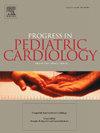Treatment of patent foramen ovale in children and adolescents
IF 0.6
Q4 PEDIATRICS
引用次数: 0
Abstract
Background
Patent foramen ovale is a fetal communication between the atria that is caused by incompetence of the valve of the oval fossa. It is a common incidental finding on echocardiography in about 25 % of adults.
Aim of review
The purpose of this article is to review patent foramen ovale in children and adolescents, associated clinical conditions, and treatment options.
Key scientific concepts of review
Patent foramen ovale can be associated with a range of morbidities, including migraine headaches, cryptogenic ischemic stroke, transient ischemic attack, paradoxical embolus, syncope, decompression sickness, and platypnea-orthodeoxia syndrome (a rare condition leading to dyspnea and hypoxemia when standing or sitting upright). Notably, a patent foramen ovale is more prevalent in patients having migraines with aura (50 %) than those without aura (27 %). Closure of patent foramen ovale has been observed to reduce the median number of migraine days, although it does not impact overall headache frequency. Patent foramen ovale, as a cardiac anomaly, is found in a significant proportion of pediatric stroke cases due to its potential for paradoxical emboli shunting to the brain. In the pediatric population, percutaneous patent foramen ovale closure is safe and, when combined with antiplatelet therapy, effectively reduces the risk of new brain infarcts and stroke recurrence. Young patients with sickle cell disease and patent foramen ovale have an increased risk of bleeding while on anticoagulation therapy; hence, transcatheter patent foramen ovale closure is preferable to prevent neurological sequelae. Additionally, there is evidence showing a four-fold higher frequency of syncope in patients with patent foramen ovale, suggesting a significant association. The 2020 American Academy of Neurology Practice Advisory recommends patent foramen ovale closure for secondary stroke prevention in patients under 60 with embolic strokes of unknown etiology. When clinically indicated, patent foramen ovale closure is a feasible and safe intervention in children and adolescents, promising to reduce stroke-related morbidity.
求助全文
约1分钟内获得全文
求助全文
来源期刊

PROGRESS IN PEDIATRIC CARDIOLOGY
PEDIATRICS-
CiteScore
0.90
自引率
11.10%
发文量
69
审稿时长
75 days
期刊介绍:
Progress in Pediatric Cardiology is an international journal of review presenting information and experienced opinion of importance in the understanding and management of cardiovascular diseases in children. Each issue is prepared by one or more Guest Editors and reviews a single subject, allowing for comprehensive presentations of complex, multifaceted or rapidly changing topics of clinical and investigative interest.
 求助内容:
求助内容: 应助结果提醒方式:
应助结果提醒方式:


